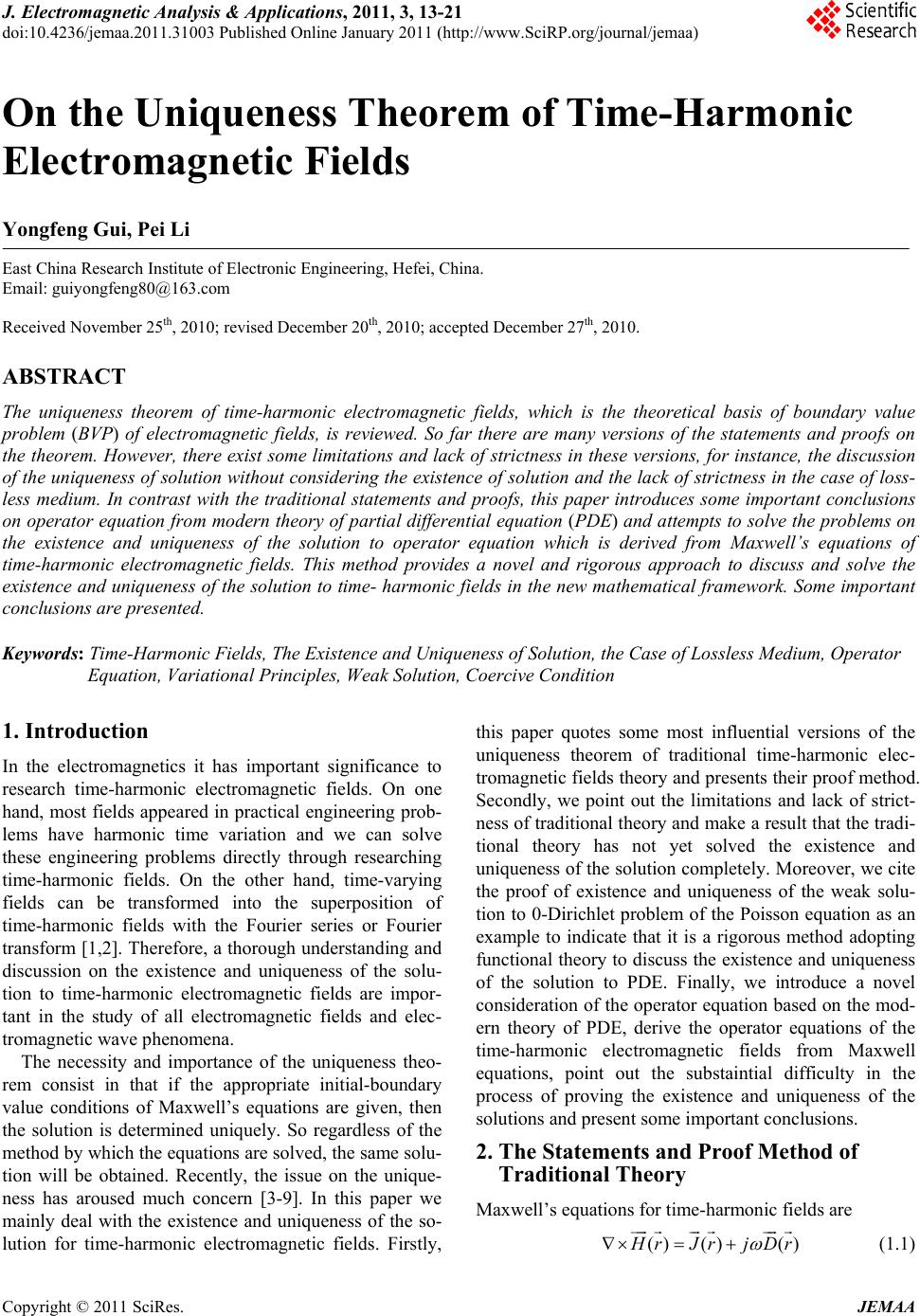 J. Electromagnetic Analysis & Applications, 2011, 3, 13-21 doi:10.4236/jemaa.2011.31003 Published Online January 2011 (http://www.SciRP.org/journal/jemaa) Copyright © 2011 SciRes. JEMAA 13 On the Uniqueness Theorem of Time-Harmonic Electromagnetic Fields Yongfeng Gui, Pei Li East China Research Institute of Electronic Engineering, Hefei, China. Email: guiyongfeng80@163.com Received November 25th, 2010; revised December 20th, 2010; accepted December 27th, 2010. ABSTRACT The uniqueness theorem of time-harmonic electromagnetic fields, which is the theoretical basis of boundary value problem (BVP) of electromagnetic fields, is reviewed. So far there are many versions of the statements and proofs on the theorem. However, there exist some limitations and lack of strictness in these versions, for instance, the discussion of the uniqueness of solution without considering the existence of solution and the lack of strictness in the case of loss- less medium. In contrast with the traditional statements and proofs, this paper introduces some important conclusions on operator equ ation from modern theory of partial differen tial equation (PDE) and attempts to solve the p roblems on the existence and uniqueness of the solution to operator equation which is derived from Maxwell’s equations of time-harmonic electromagnetic fields. This method provides a novel and rigorous approach to discuss and solve the existence and uniqueness of the solution to time- harmonic fields in the new mathematical framework. Some important conclusions are presente d . Keywords: Time-Harmonic Fields, The Existence and Uniqueness of Solution, the Case of Lossless Medium, Operator Equation, Variational Principles, Weak Solution, Coercive Condition 1. Introduction In the electromagnetics it has important significance to research time-harmonic electromagnetic fields. On one hand, most fields appeared in practical engineering prob- lems have harmonic time variation and we can solve these engineering problems directly through researching time-harmonic fields. On the other hand, time-varying fields can be transformed into the superposition of time-harmonic fields with the Fourier series or Fourier transform [1,2]. Therefore, a thorough understanding and discussion on the existence and uniqueness of the solu- tion to time-harmonic electromagnetic fields are impor- tant in the study of all electromagnetic fields and elec- tromagnetic wave phenomena. The necessity and importance of the uniqueness theo- rem consist in that if the appropriate initial-boundary value conditions of Maxwell’s equations are given, then the solution is determined uniquely. So regardless of the method by which the equations are solved, the same solu- tion will be obtained. Recently, the issue on the unique- ness has aroused much concern [3-9]. In this paper we mainly deal with the existence and uniqueness of the so- lution for time-harmonic electromagnetic fields. Firstly, this paper quotes some most influential versions of the uniqueness theorem of traditional time-harmonic elec- tromagnetic fields theory and presents their proof method. Secondly, we point out the limitations and lack of strict- ness of traditional theory and make a result that the tradi- tional theory has not yet solved the existence and uniqueness of the solution completely. Moreover, we cite the proof of existence and uniqueness of the weak solu- tion to 0-Dirichlet problem of the Poisson equation as an example to indicate that it is a rigorous method adopting functional theory to discuss the existence and uniqueness of the solution to PDE. Finally, we introduce a novel consideration of the operator equation based on the mod- ern theory of PDE, derive the operator equations of the time-harmonic electromagnetic fields from Maxwell equations, point out the substaintial difficulty in the process of proving the existence and uniqueness of the solutions and present some important conclusions. 2. The Statements and Proof Method of Traditional Theory Maxwell’s equations for time-harmonic fields are () ()() rJrjDr (1.1) 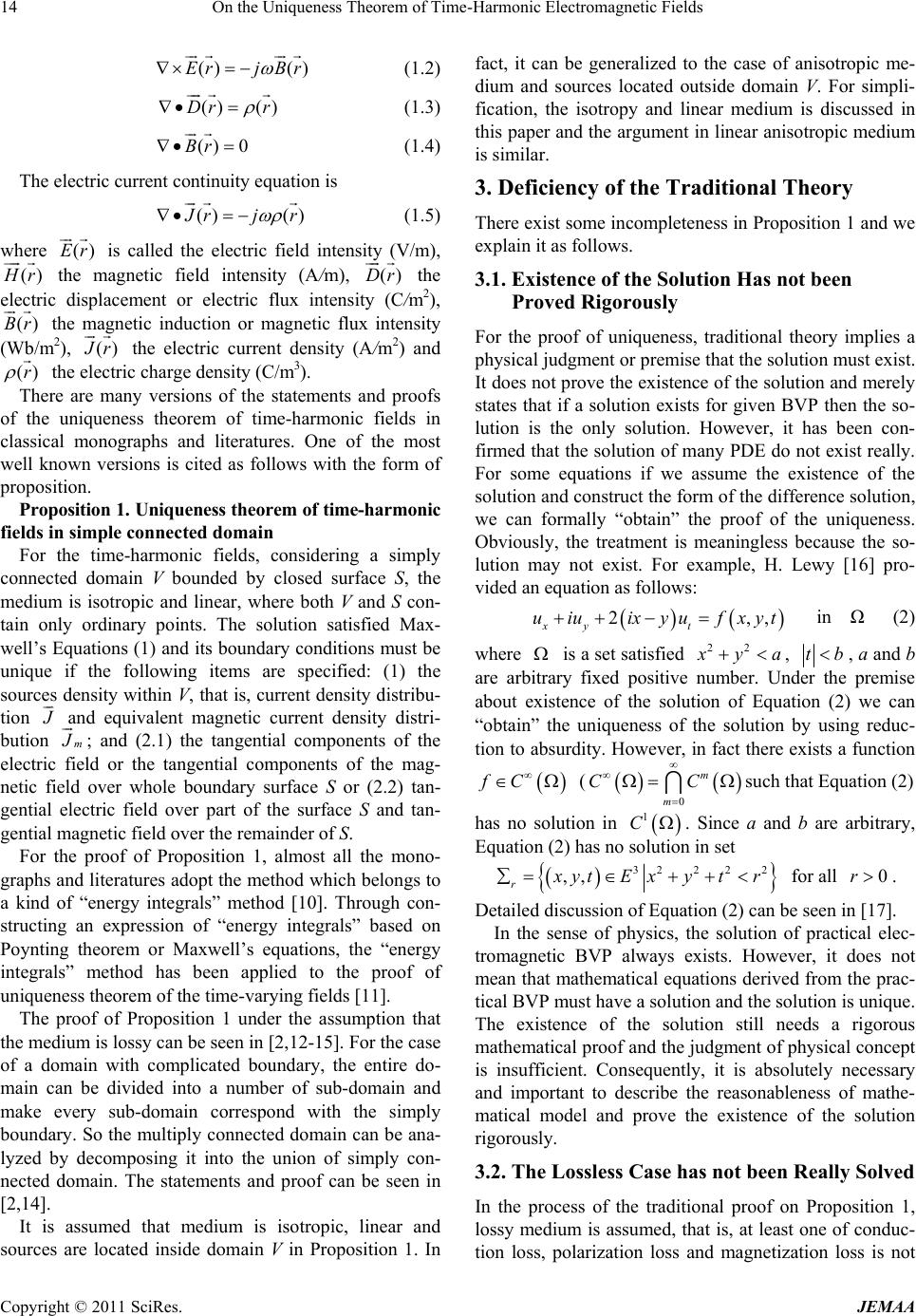 On the Uniqueness Theorem of Time-Harmonic Electromagnetic Fields 14 () ()Erj Br (1.2) () ()Dr r (1.3) () 0Br (1.4) The electric current continuity equation is () () rjr (1.5) w is called the electric field intensi/m), here ty (V ()Er () r the magnetic field intensity (A/m), ()Dr the electric displacement or electric flux intensity (C/m2), the metic induction or magnetic flux intensity (Wb/m2), ()Br agn () r the electric current density (A/m2) and ()r the electric charge density (C/m3). There are many versions of the statements and proofs of the uniqueness theorem of time-harmonic fields in classical monographs and literatures. One of the most well known versions is cited as follows with the form of proposition. Proposition 1. Uniqueness theorem of time-harmonic fields in simple connected domain For the time-harmonic fields, considering a simply connected domain V bounded by closed surface S, the medium is isotropic and linear, where both V and S con- tain only ordinary points. The solution satisfied Max- well’s Equations (1) and its boundary conditions must be unique if the following items are specified: (1) the sources density within V, that is, current density distribu- tion and equivalent magnetic current density distri- bution m ; and (2.1) the tangential components of the electric field or the tangential components of the mag- netic field over whole boundary surface S or (2.2) tan- gential electric field over part of the surface S and tan- gential magnetic field over the remainder of S. For the proof of Proposition 1, almost all the mono- graphs and literatures adopt the method which belongs to a kind of “energy integrals” method [10]. Through con- structing an expression of “energy integrals” based on Poynting theorem or Maxwell’s equations, the “energy integrals” method has been applied to the proof of uniqueness theorem of the time-varying fields [11]. The proof of Proposition 1 under the assumption that the medium is lossy can be seen in [2,12-15]. For the case of a domain with complicated boundary, the entire do- main can be divided into a number of sub-domain and make every sub-domain correspond with the simply boundary. So the multiply connected domain can be ana- lyzed by decomposing it into the union of simply con- nected domain. The statements and proof can be seen in [2,14]. It is assumed that medium is isotropic, linear and sources are located inside domain V in Proposition 1. In fact, it can be generalized to the case of anisotropic me- dium and sources located outside domain V. For simpli- fication, the isotropy and linear medium is discussed in this paper and the argument in linear anisotropic medium is similar. 3. Deficiency of the Traditional Theory There exist some incompleteness in Proposition 1 and we explain it as follows. 3.1. Existence of the Solution Has not been Proved Rigorously For the proof of uniqueness, traditional theory implies a physical judgment or premise that the solution must exist. It does not prove the existence of the solution and merely states that if a solution exists for given BVP then the so- lution is the only solution. However, it has been con- firmed that the solution of many PDE do not exist really. For some equations if we assume the existence of the solution and construct the form of the difference solution, we can formally “obtain” the proof of the uniqueness. Obviously, the treatment is meaningless because the so- lution may not exist. For example, H. Lewy [16] pro- vided an equation as follows: 2 xy t uiuixyu fxyt ,, in Ω (2) where is a set satisfied 22 ya, tb, a and b are arbitrary fixed positive number. Under the premise about existence of the solution of Equation (2) we can “obtain” the uniqueness of the solution by using reduc- tion to absurdity. However, in fact there exists a function fC ( 0 m m CC such that Equation (2) has no solution in C1 . Since a and b are arbitrary, Equation (2) has no solution in set 322 22 ,, r ytE xytr for all . 0r Detailed discussion of Equation (2) can be seen in [17]. In the sense of physics, the solution of practical elec- tromagnetic BVP always exists. However, it does not mean that mathematical equations derived from the prac- tical BVP must have a solution and the solution is unique. The existence of the solution still needs a rigorous mathematical proof and the judgment of physical concept is insufficient. Consequently, it is absolutely necessary and important to describe the reasonableness of mathe- matical model and prove the existence of the solution rigorously. 3.2. The Lossless Case has not been Really Solved In the process of the traditional proof on Proposition 1, lossy medium is assumed, that is, at least one of conduc- tion loss, polarization loss and magnetization loss is not Copyright © 2011 SciRes. JEMAA 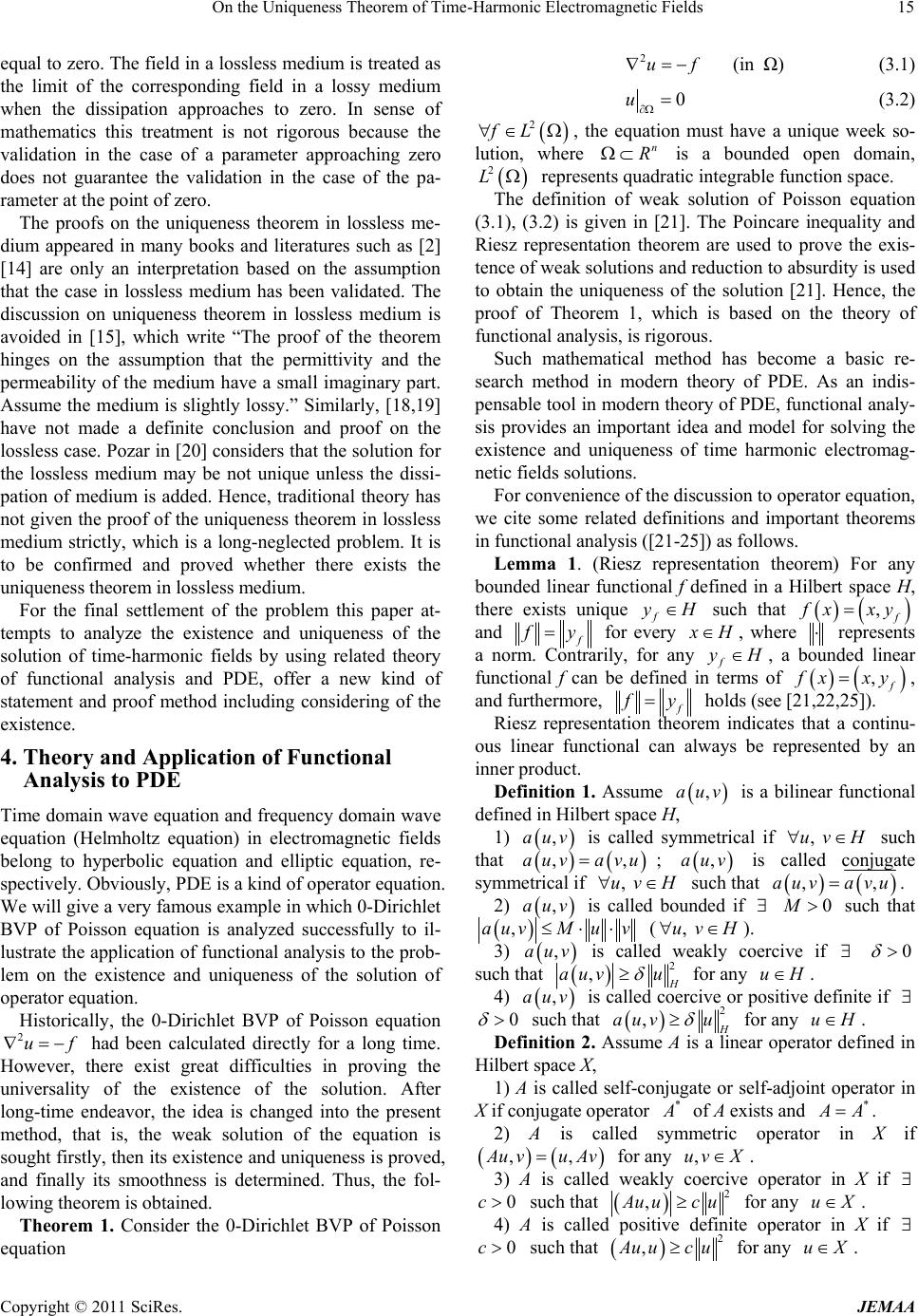 On the Uniqueness Theorem of Time-Harmonic Electromagnetic Fields15 ess theorem in lossless me- di this paper at- te y and Application of Functional Tition and frequency domain wave 0-Dirichlet BVP of Poisson equation 0-Dirichlet BVP of Poisson eq equal to zero. The field in a lossless medium is treated as the limit of the corresponding field in a lossy medium when the dissipation approaches to zero. In sense of mathematics this treatment is not rigorous because the validation in the case of a parameter approaching zero does not guarantee the validation in the case of the pa- rameter at the point of zero. The proofs on the uniquen um appeared in many books and literatures such as [2] [14] are only an interpretation based on the assumption that the case in lossless medium has been validated. The discussion on uniqueness theorem in lossless medium is avoided in [15], which write “The proof of the theorem hinges on the assumption that the permittivity and the permeability of the medium have a small imaginary part. Assume the medium is slightly lossy.” Similarly, [18,19] have not made a definite conclusion and proof on the lossless case. Pozar in [20] considers that the solution for the lossless medium may be not unique unless the dissi- pation of medium is added. Hence, traditional theory has not given the proof of the uniqueness theorem in lossless medium strictly, which is a long-neglected problem. It is to be confirmed and proved whether there exists the uniqueness theorem in lossless medium. For the final settlement of the problem mpts to analyze the existence and uniqueness of the solution of time-harmonic fields by using related theory of functional analysis and PDE, offer a new kind of statement and proof method including considering of the existence. 4. Theor Analysis to PDE me domain wave equa equation (Helmholtz equation) in electromagnetic fields belong to hyperbolic equation and elliptic equation, re- spectively. Obviously, PDE is a kind of operator equation. We will give a very famous example in which 0-Dirichlet BVP of Poisson equation is analyzed successfully to il- lustrate the application of functional analysis to the prob- lem on the existence and uniqueness of the solution of operator equation. Historically, the 2uf had been calculated directly for a long time. there exist great difficulties in proving the universality of the existence of the solution. After long-time endeavor, the idea is changed into the present method, that is, the weak solution of the equation is sought firstly, then its existence and uniqueness is proved, and finally its smoothness is determined. Thus, the fol- lowing theorem is obtained. Theorem 1. Consider the However, uation 2uf (in Ω) (3.1) 0u (3.2) 2 fL lution, wher , the equation must have a unique week so- e n R is a bounded open domain, 2 L represenatic integrable function space. definition of weak solution of Poisson equatio ts quadr The n (3 has become a basic re- se e discussion to operator equation, w ) For any bo .1), (3.2) is given in [21]. The Poincare inequality and Riesz representation theorem are used to prove the exis- tence of weak solutions and reduction to absurdity is used to obtain the uniqueness of the solution [21]. Hence, the proof of Theorem 1, which is based on the theory of functional analysis, is rigorous. Such mathematical method arch method in modern theory of PDE. As an indis- pensable tool in modern theory of PDE, functional analy- sis provides an important idea and model for solving the existence and uniqueness of time harmonic electromag- netic fields solutions. For convenience of th e cite some related definitions and important theorems in functional analysis ([21-25]) as follows. Lemma 1. (Riesz representation theorem unded linear functional f defined in a Hilbert space H, there exists unique f yH such that , xxy and y for every H, where represents a norily, for anyH, a bded linear functional f can be defined inf rm. Contra f y term oun s o , xxy, and furthermore, y holds (see [2 Riesz representation tem indicates that a conti 1,22,25]). nu-he ou . Assume or s linear functional can always be represented by an inner product. Definition 1 ,auv , is a bilinear functional defined in Hilbert space H 1) ,auv is called symmetrical if such th , uv H at ,avu; ,auv is cjugate symm H , , uv auv etrical if alled con such that ,,auvavu. 2) ,auv is called unded if atbo 0M such th ,u vauvM (, uvH ). ,auv is called weakly coercive if 3) 0 suhat ch t 2 , auv u for any uH. 4) ,v au rcive or po dis called coeesitivefinite if 0 hat such t2 , auv u for any uH. inition 2. AinDef ssume A is a linear operator ed H onjugate or self-adjoint operator in X def in ilbert space X, 1) A is called self-c if conjugate operator * of A exists and * A . 2) A is called symmetric operatorX in if ,, uv uAv for any ,uv X. weakly c operator i3) A is calledoerciven X if 0 such that c2 , uu cu for any uX. A is called 4) positive definite operator ifin X 0 such that c2 , uu cu for any uX. Copyright © 2011 SciRes. JEMAA 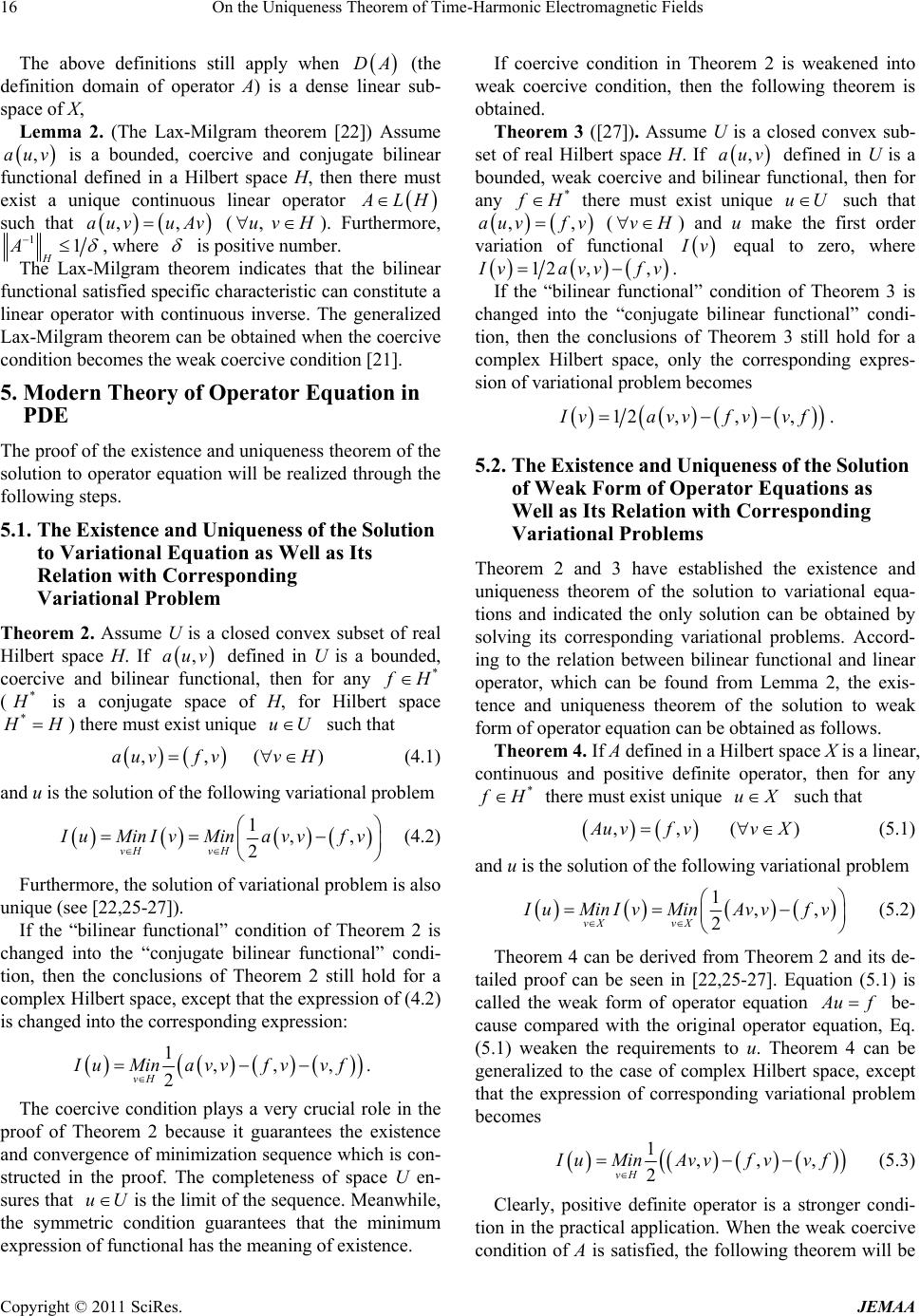 On the Uniqueness Theorem of Time-Harmonic Electromagnetic Fields 16 Th initions still apply when e above def DA (the de . (The Lax-Milgram theorem [22]) Assume finition domain of operator A) is a dense linear sub- space of X, Lemma 2 ,uv is a bounded, coercive and conjugate bilinear al defined in a Hilbert space H, then there must exist a unique continuous linear operator a function LH such that ,,auv uAv (, uvH ). Fu rthermore, 11 H A , where is fu Thof the existence and uniqueness theorem of the and Uniquene ss of th e Solu tion The losed convex subset of real poser. ilgram theorem indicates that t itive numb The Lax-Mhe bilinear nctional satisfied specific characteristic can constitute a linear operator with continuous inverse. The generalized Lax-Milgram theorem can be obtained when the coercive condition becomes the weak coercive condition [21]. 5. Modern Theory of Operator Equation in PDE e proof solution to operator equation will be realized through the following steps. 5.1. The Existence to Variational Equation as Well as Its Relation with Corresponding Variational Problem orem 2. Assume U is a c Hilbert space H. If ,auv defined in U is a bounded, coercive and bilineaional, then for any * r funct H (* is a conjugate space of H, for Hilbert space * H) there must exist unique uU such that ,, ()auv fv ( v H4.1) and u is the solution of the following variational problem 1,, 2 vH vH uMinIvMinavv fv (4.2) Furthermore, the solution of variational problem is also un nal” condition of Theorem 2 is ch ique (see [22,25-27]). If the “bilinear functio anged into the “conjugate bilinear functional” condi- tion, then the conclusions of Theorem 2 still hold for a complex Hilbert space, except that the expression of (4.2) is changed into the corresponding expression: ,, , 2 vH 1 uMinavvfv vf . The coercive condition plays a very crucial role in the pr tric c to w 3 ([27]). Assume U is a closed convex sub- se oof of Theorem 2 because it guarantees the existence and convergence of minimization sequence which is con- structed in the proof. The completeness of space U en- sures that uUis the limit of the sequence. Meanwhile, the symmeondition guarantees that the minimum expression of functional has the meaning of existence. If coercive condition in Theorem 2 is weakened in eak coercive condition, then the following theorem is obtained. Theorem t of real Hilbert space H. If ,auv defined in U is a bounded, weak coercive and bilinear functional, then for any * H there must exist unique uU such that ,,au v (vHv f ) and u makefirst order nc the variatio fun oftional v equal to zero, where 12 ,, vavvfv. If the “bilinear functional” condition of Theorem 3 is changed into the “conjugate bilinear functional” condi- tion, then the conclusions of Theorem 3 still hold for a complex Hilbert space, only the corresponding expres- sion of variational problem becomes ,12 ,, vavvfvvf . 5.2. The Existence and Unique ne ss of th e Solu tion Theolished the existence and ear, co of Weak Form of Operator Equations as Well as Its Relation with Corresponding Variational Problems rem 2 and 3 have estab uniqueness theorem of the solution to variational equa- tions and indicated the only solution can be obtained by solving its corresponding variational problems. Accord- ing to the relation between bilinear functional and linear operator, which can be found from Lemma 2, the exis- tence and uniqueness theorem of the solution to weak form of operator equation can be obtained as follows. Theorem 4. If A defined in a Hilbert space X is a lin ntinuous and positive definite operator, then for any * H there must exist unique uX such that ,, () uvf v (v X5.1) and u is the solution of the following variational problem 1 ,, 2 vX vX uMinIvMin Avvfv (5.2) Theorem 4 can be derived from Theorem 2 and its de- ta iled proof can be seen in [22,25-27]. Equation (5.1) is called the weak form of operator equation uf be- cause compared with the original operator equation, Eq. (5.1) weaken the requirements to u. Theorem 4 can be generalized to the case of complex Hilbert space, except that the expression of corresponding variational problem becomes 1,,, 2 vH uMinAvvfv vf (5.3) Clearly, positive definite operator is a stronger condi- tion in the practical application. When the weak coercive condition of A is satisfied, the following theorem will be Copyright © 2011 SciRes. JEMAA  On the Uniqueness Theorem of Time-Harmonic Electromagnetic Fields17 5. If A defined in a Hilbert space X is a linear, co obtained. Theorem ntinuous and weak coercive operator, then for any * H there must be unique X such that ,, () xvf v v X (6.1) and x satisfied , where 0Ix 1,, 2 xAxxfx (6.2) that is, x make the first order variation of functional x equal to zero [27]. proof of Theorem 5 Thecan be realized through taking advantage of the conclusion of Theorem 3. Theorem 5 can be generalized to the case of complex Hilbert space, except that the functional expression of corresponding variational problem becomes 1,,, 2 xAxxfxxf (6.3) 5.3. The Existence and Uniqueness Theorem of Let rt space H Solution to Operator Equation ()DA be a linear dense set in real Hilbe and or A be mapping from ()DA to H. For sim- plification, we assume the discussuation operat ed eq uf belongs to a kind of BVP of differential equation. time operator A is a differential operator and domain ()DA consists of smooth functions with certain differ- order, which is greater or equal the order of differ- ential operator. Therefore, the solutions of BVP on linear set ()DA belong to the common sense solutions. If BVP solutions on ()DA, then the solutions is called classical solution of or its equivalent varia- tional problems. However, in general we can not guaran- tee the existence of the solution to operator equation or variational problem. For BVP of Poisson equation in Theorem 1, if function f has no continuity on bound- ary , then the equation has no solution in linear set At this ential have BVP 2,0DuCu . But, when ()DA is extended A to a linear set of Sobolev space 12 0,HvLDv 2 ,0Lv , at this time the weak form of the original equation on r dense set in erato expended domain always has solutions. Obviously, this solution is not the solution of the original BVP in the sense of classical signification and is called a weak solu- tion of the original equation [28-30]. We will build the connection between operator equation and variational problem through the weak form of operator equation and obtain the existence and uniqueness proposition of op- erator equation in the sense of weak solution. Proposition 2 ([25]). Let DA be a linea real Hilbert space X and opr A: DA X. For operator equation ufuDA ( can be extended 7.1) where the definition domain of Ato space A , A is a Hilbert space which is obtained by comple otionf DA in terms of norm A and , A uAuu is a linear, continuous, sym. If Ametric and positive def y inite operator, then the following conclu- sions hold. 1) for an * X there must exist unique 0A uH such that 0,, (A) uvfvv H (7.2) and is the only solution of the following 0 u lem variational prob 1,, 2 AA vH vH uMinIvMin Avvfv (7.3) 2) If 0 uDA .1). If , then is the classical solution of Eq 0 u uation (7 0 uD, then 0 u is the weak so- lution of Equation ( Proof: It can be proved A 7.1). directly by using Theorem 4 an ork and (7.3) co d, the following proposi- tio . Let be a linear dense set in )) d the definition of weak solution directly. (7.2) corresponds to principle of virtual w rresponds to energy method. If the conditions is weakene n will be obtained. Proposition 3([27]) DA perato real Hilbert space X and or A: DA X. For operator equation (( ufuDA (8.1) where the domain of A can be extended to space A . If A is a linear, continuous, symmetric and weak coive operator, then the following conclusions hold. 1) for any * erc X there must exist unique 0A uH such that 0,, (A) uvfvvH (8.2) and satisfied 0 u 00Iu , where 1,, 2 uAuuf u (8.3) 2) If 0 uDA (11.1). If , then is the classical solution of Eq be generalized to the case of co 0 u . uation 0 uDA, then 0 u is the weak solution of Equation ( Proposition 2 and 3 can 8.1) mplex Hilbert space, only need to change the func- tional expression of corresponding variational problem (7.3) and (8.3) into (5.3) and (6.3). In Proposition 2 and 3, symmetry condition guarantees that the values of func- tional expression must be real and makes the computation of extreme values feasible. The positive definite or weak Copyright © 2011 SciRes. JEMAA 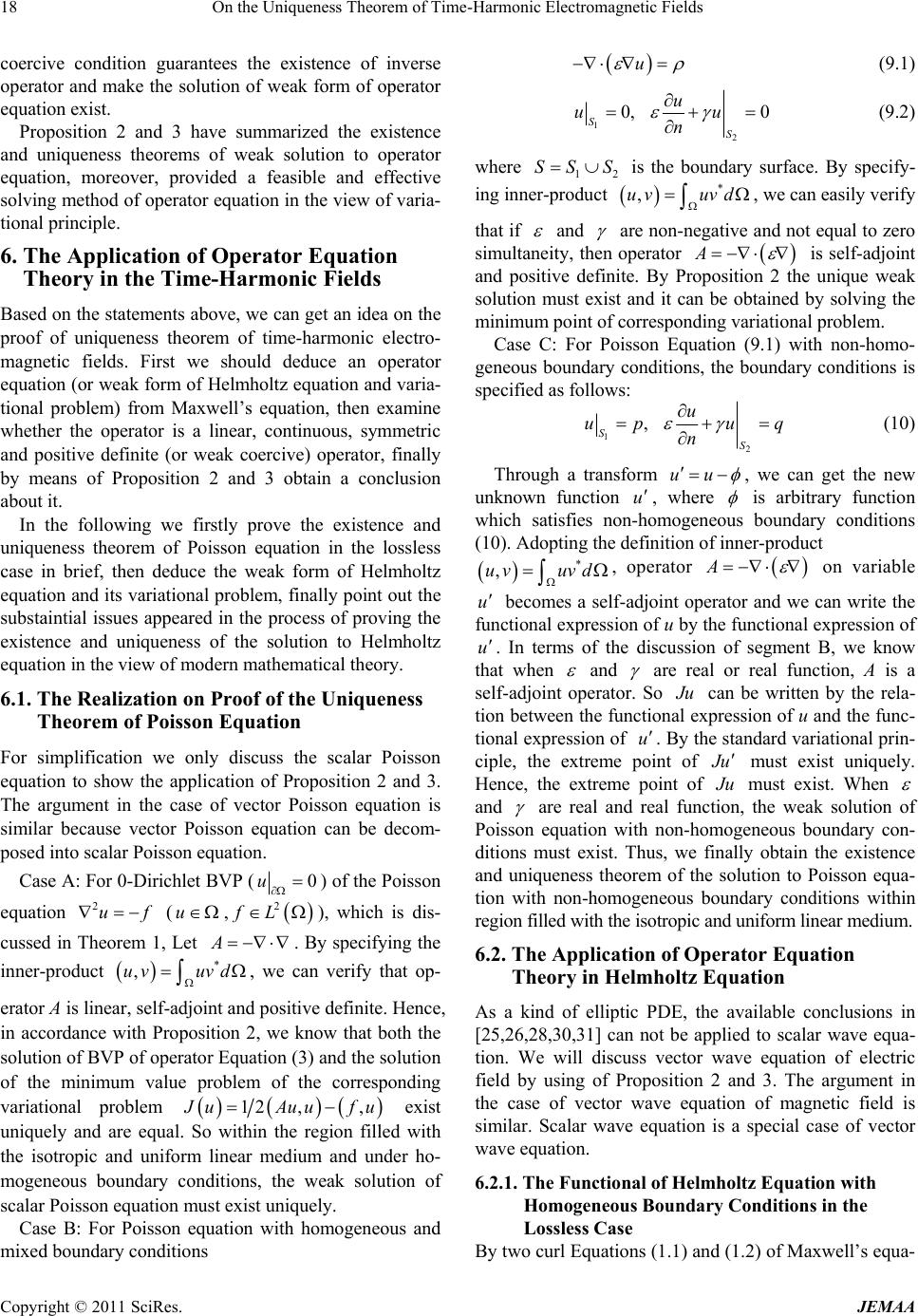 On the Uniqueness Theorem of Time-Harmonic Electromagnetic Fields 18 coercive condition guarantees the existence of inverse operator and make the solution of weak form of operator equation exist. Proposition 2 and 3 have summarized the existence an ation of Operator Equation Baon the following we firstly prove the existence and un s For e scalar Poisson d uniqueness theorems of weak solution to operator equation, moreover, provided a feasible and effective solving method of operator equation in the view of varia- tional principle. 6. The Applic Theory in the Time-Harmonic Fields sed on the statements above, we can get an idea proof of uniqueness theorem of time-harmonic electro- magnetic fields. First we should deduce an operator equation (or weak form of Helmholtz equation and varia- tional problem) from Maxwell’s equation, then examine whether the operator is a linear, continuous, symmetric and positive definite (or weak coercive) operator, finally by means of Proposition 2 and 3 obtain a conclusion about it. In the iqueness theorem of Poisson equation in the lossless case in brief, then deduce the weak form of Helmholtz equation and its variational problem, finally point out the substaintial issues appeared in the process of proving the existence and uniqueness of the solution to Helmholtz equation in the view of modern mathematical theory. 6.1. The Realization on Proof of the Uniquenes Theorem of Poisson Equation simplification we only discuss th equation to show the application of Proposition 2 and 3. The argument in the case of vector Poisson equation is similar because vector Poisson equation can be decom- posed into scalar Poisson equation. Case A: For 0-Dirichlet BVP (0u 2 L ) of the Poisson eq 1, L uation 2uf (u,f), which is dis- cussed in Theoremet A . By specifying the inner-product ,u vuv can verify that op- *d , we ar, self-adjoint and positiveerator A is line definite. Hence, in accordance with Proposition 2, we know that both the solution of BVP of operator Equation (3) and the solution of the minimum value problem of the corresponding variational problem 12 ,, uAuufu exist uniquely and are equal.d with the isotropic and uniform linear medium and under ho- mogeneous boundary conditions, the weak solution of scalar Poisson equation must exist uniquely. Case B: For Poisson equation with homog So within the region fille eneous and mixed boundary conditions u (9.1) 1 2 0, 0 SS u uu n (9.2) where 12 SS S is the boundary surface. By specify- r-product ing inne * ,uvuv d , we can easily verify that if and are non-negative and not equal to zero simultaneity, then operator A is self-adjoint and positive definite. By Pre unique weak solution must exist and it can be obtained by solving the minimum point of corresponding variational problem. Case C: For Poisson Equation (9.1) with non-hom oposition 2 th o- geneous boundary conditions, the boundary conditions is specified as follows: 1 2 , SS u up uq n (10) Through a transform uu , we can get the new unknown function u , where is arbitrary function which satisfies non-homogeneous boundary conditions (10). Adopting the definition of inner-product * ,uv uvd , operator A on variable u fun becomes a serator and welf-adjoint ope can write the ctional expression of u by the functional expression of u . In terms of the discussion of segment B, we know t when tha and are real or real function, A is a self-adjoint operatorSo . u can be written by the rela- tion between the functionxpression of u and the func- tional expression of ual e . By the standard variational prin- ciple, the extreme pint of o u must exist uniquely. Hence, the extreme point of u must exist. When and are real and real funct, the weak solution of Poissn equation with non-homogeneous boundary con- ditions must exist. Thus, we finally obtain the existence and uniqueness theorem of the solution to Poisson equa- tion with non-homogeneous boundary conditions within region filled with the isotropic and uniform linear medium. 6.2. The Application of Operator Equation ion o As a conclusions in tional of Helmholtz Equation with By tw (1.1) and (1.2) of Maxwell’s equa- Theory in Helmholtz Equation kind of elliptic PDE, the available [25,26,28,30,31] can not be applied to scalar wave equa- tion. We will discuss vector wave equation of electric field by using of Proposition 2 and 3. The argument in the case of vector wave equation of magnetic field is similar. Scalar wave equation is a special case of vector wave equation. 6.2.1. The Func Homogeneous Boundary Conditions in the Lossless Case o curl Equations Copyright © 2011 SciRes. JEMAA 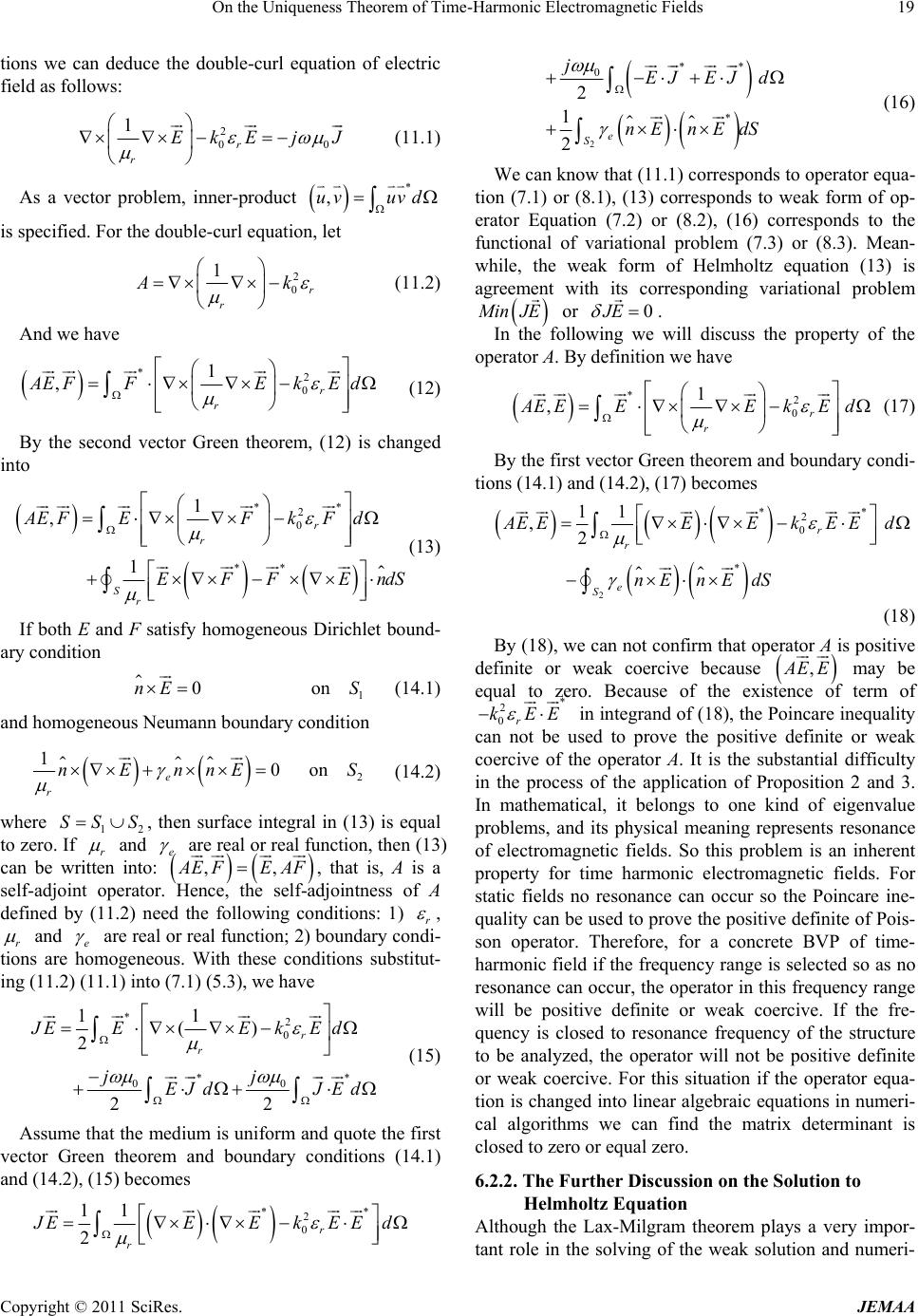 On the Uniqueness Theorem of Time-Harmonic Electromagnetic Fields19 tions we can deduce the double-curl equation of electric field as follows: 2 00 1 r r EkEj J (11.1) As a vector problem, inner-product is * ,uv uvd specified. For the double-curl equation, let 2 0 1 r r k (11.2) And we have *2 0 1 ,r r EFFE k Ed (12) By the second vector Green theorem, (12) is changed in to ** 2 0 ** 1 , 1 r r Sr AE FEFkFd EFF En dS (13) If both E and F satisfy homogeneous Dirichlet bound- ary condition 1 0 on nE S (14.1) and homogeneous Neumann boundary condition 2 1 0 on e r nEnnE S (14.2) where , then surface integral in (13) is equal 12 SS S If r to zero. and e are real or real function, then (13) can be wri into: ,, tten EF EAF , that is, A is a self-adjoint operator. djointness of A defined by (11.2) need the following conditions: 1) r Hence, the self-a , r and e are real or real function; 2) boundary con- s are mogeneous. With these conditions substitut- ing (11.2) (11.1) into (7.1) (5.3), we have di tion ho *2 11 0 ** 00 () 2 22 r r JEEEkE d jj EJd JEd (15) Assume that the medium is uniform and quote the first vector Green theorem and boundary conditions (14.1) and (14.2), (15) becomes ** 2 0 11 2 ** 0 * 2 1 2e S jEJEJ d nE nEdS (16) We can know that (11.1) corresponds tion (7.1) or (8.1), (13) corresponds to weak form of op- erator Equation (7.2) or (8.2), (16) corresponds to the fu to operator equa- nctional of variational problem (7.3) or (8.3). Mean- while, the weak form of Helmholtz equation (13) is agreement with its corresponding variational problem in JE or 0JE . In the following we will discuss the property of the operator A. By definition we have *2 0 1 , r r EEEEkE d (17) By the first vector Green theorem and boundary tions (14.1) and (14.2), (17) becomes condi- ** 2 0 11 , 2r r 2 * e S EEEEkEE d nE nEdS (18 By (18), we can not confirm that operator A is positive definite or weak coercive because ) , EE e of may equal to zero. Because of the existenc term be of 2r r EEEkEEd * 2 0r kEE in integrand of (18), the Plity can not be used to prove the positive definite or weak coercive of the operator A. It is the substantial difficulty ss of the application of Proposition 2 and 3. In mathematical, it belongs to one kind of eigenvalue problems, and its physical meaning represents resonance of electromagnetic fields. So this problem is an inherent property for time harmonic electromagnetic fields. For static fields no resonance can occur so the Poincare ine- quality can be used to prove the positive definite of Pois- son operator. Therefore, for a concrete BVP of time- harmonic field if the frequency range is selected so as no resonance can occur, the operator in this frequency range will be positive definite or weak coercive. If the fre- quency is closed to resonance frequency of the structure to be analyzed, the operator will not be positive definite or weak coercive. For this situation if the operator equa- tion is changed into linear algebraic equations in numeri- cal algorithms we can find the matrix determinant is closed to zero or equal zero. 6.2.2. The Further Discussion on the Solution to Helmholtz Equation Although the Lax-Milgram theo oincare inequa in the proce rem plays a very impor- meri- tant role in the solving of the weak solution and nu Copyright © 2011 SciRes. JEMAA 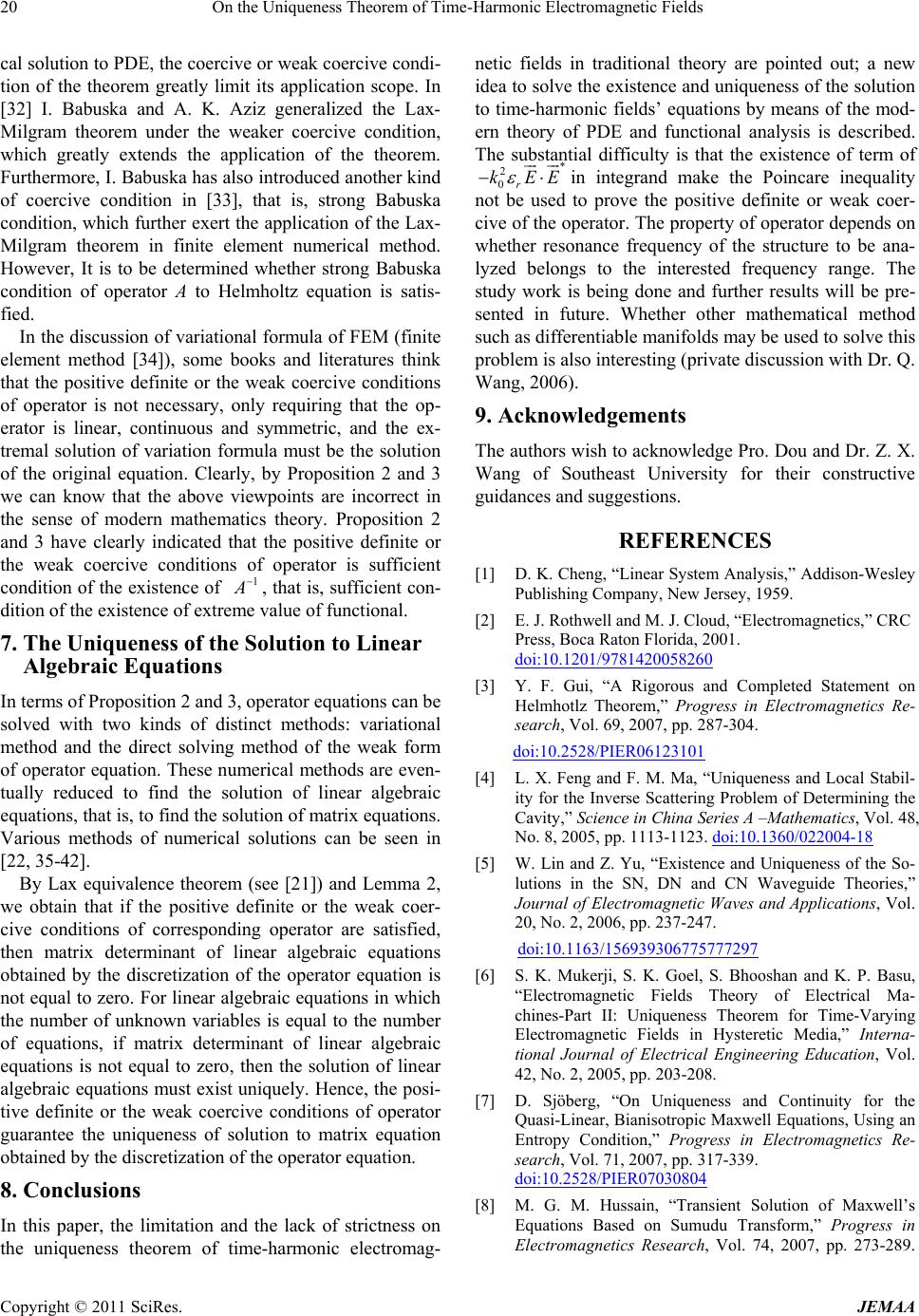 On the Uniqueness Theorem of Time-Harmonic Electromagnetic Fields 20 cal solive or weak coercive condi- e positive definite or the weak coercive conditions of ution to PDE, the coerc tion of the theorem greatly limit its application scope. In [32] I. Babuska and A. K. Aziz generalized the Lax- Milgram theorem under the weaker coercive condition, which greatly extends the application of the theorem. Furthermore, I. Babuska has also introduced another kind of coercive condition in [33], that is, strong Babuska condition, which further exert the application of the Lax- Milgram theorem in finite element numerical method. However, It is to be determined whether strong Babuska condition of operator A to Helmholtz equation is satis- fied. In the discussion of variational formula of FEM (finite element method [34]), some books and literatures think that th operator is not necessary, only requiring that the op- erator is linear, continuous and symmetric, and the ex- tremal solution of variation formula must be the solution of the original equation. Clearly, by Proposition 2 and 3 we can know that the above viewpoints are incorrect in the sense of modern mathematics theory. Proposition 2 and 3 have clearly indicated that the positive definite or the weak coercive conditions of operator is sufficient condition of the existence of 1 , that is, sufficient con- dition of the existence of extreme value of functional. 7. The Uniqueness of the Solution to Linear Algebraic Equations In terms of Proposition 2 and 3, operator equations can b solved with two kinds of distinct methods: variationa thod and the direct solving e l me method of the weak form ns of corresponding operator are satisf th the uniqueness theorem of time-harmonic electromag- tional theory are pointed out; a new of operator equation. These numerical methods are even- tually reduced to find the solution of linear algebraic equations, that is, to find the solution of matrix equations. Various methods of numerical solutions can be seen in [22, 35-42]. By Lax equivalence theorem (see [21]) and Lemma 2, we obtain that if the positive definite or the weak coer- cive conditioied, en matrix determinant of linear algebraic equations obtained by the discretization of the operator equation is not equal to zero. For linear algebraic equations in which the number of unknown variables is equal to the number of equations, if matrix determinant of linear algebraic equations is not equal to zero, then the solution of linear algebraic equations must exist uniquely. Hence, the posi- tive definite or the weak coercive conditions of operator guarantee the uniqueness of solution to matrix equation obtained by the discretization of the operator equation. 8. Conclusions In this paper, the limitation and the lack of strictness on netic fields in tradi idea to solve the existence and uniqueness of the solution to time-harmonic fields’ equations by means of the mod- ern theory of PDE and functional analysis is described. The substantial difficulty is that the existence of term of * 2 0r kEE in integrand make the Poincare inequality not be used to prove the positive definite or weak coer- cive of the operator. The property of operator depends on whether onance frequency of the structure to be ana- lyzed belongs to the interested frequency range. The study work is being done and further results will be pre- sented in future. Whether other mathematical method such as differentiable manifolds may be used to solve this problem is also interesting (private discussion with Dr. Q. Wang, 2006). 9. Acknowledgements The authors wish to acknowledge Pro. Dou and Dr. Z. X. Wang of Sou res theast University for their constructive tem Analysis,” Addison-Wesley Publishing Company, New Jersey, 1959. [2] E. J. Rothwell omagnetics,” CRC guidances and suggestions. REFERENCES [1] D. K. Cheng, “Linear Sys and M. J. Cloud, “Electr Press, Boca Raton Florida, 2001. doi:10.1201/9781420058260 [3] Y. F. Gui, “A Rigorous and Completed Statement on Helmhotlz Theorem,” Progress in Electromagnetics Re- search, Vol. 69, 2007, pp. 287-304 doi:10.2528/PIER06123101 . [4] L. X. Feng and F. M. Ma, “Uniqueness and Local Stabil- ity for the Inverse Scattering Problem of Determining the ries A –MaCavity,” Science in China Se No. 8, 2005, pp. 1113-1123. thematics, Vol. 48, -18doi:10.1360/022004 [5] W. Lin and Z. Yu, “Existence and Uniqueness of the So- lutions in the SN, DN and CN Waveguide Theories,” Journal of Electromagnetic Waves and Applications, Vol. 20, No. 2, 2006, pp. 237-247. doi:10.1163/156939306775777297 [6] S. K. Mukerji, S. K. Goel, S. Bhooshan and K. P. Basu, “Electromagnetic Fields Theory of Electrical Ma- chines-Part II: Uniqueness Theorem for Electromagnetic Fields in Hystere Time-Varying tic Media,” Interna- 339. tional Journal of Electrical Engineering Education, Vol. 42, No. 2, 2005, pp. 203-208. [7] D. Sjöberg, “On Uniqueness and Continuity for the Quasi-Linear, Bianisotropic Maxwell Equations, Using an Entropy Condition,” Progress in Electromagnetics Re- search, Vol. 71, 2007, pp. 317- doi:10.2528/PIER07030804 [8] M. G. M. Hussain, “Transient Solution of Maxwell’s Equations Based on Sumudu Transform,” Progress in Electromagnetics Research, Vol. 74, 2007, pp. 273-289. Copyright © 2011 SciRes. JEMAA 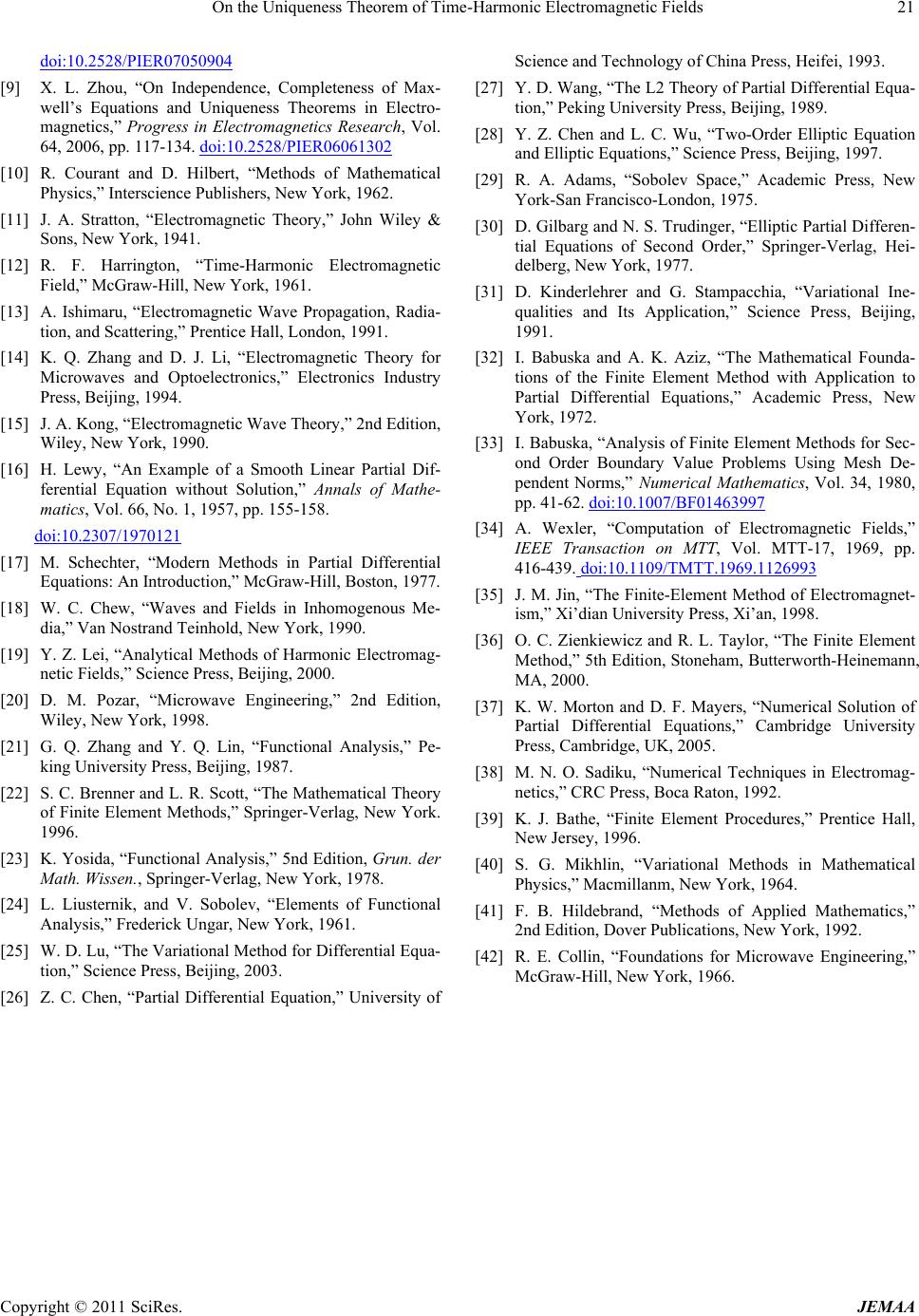 On the Uniqueness Theorem of Time-Harmonic Electromagnetic Fields Copyright © 2011 SciRes. JEMAA 21 doi:10.2528/PIER07050904 [9] X. L. Zhou, “On Independence, Completeness of Max- well’s Equations and Uniqueness Theorems in Electro- magnetics,” Progress in Electromagnetics Research, Vol. 64, 2006, pp. 117-134. doi:10.2528/PIER06061302 tice Hall, London, 1991. ctronics Industr dition thout Solution,” Annals of Mathe- [10] R. Courant and D. Hilbert, “Methods of Mathematical Physics,” Interscience Publishers, New York, 1962. [11] J. A. Stratton, “Electromagnetic Theory,” John Wiley & Sons, New York, 1941. [12] R. F. Harrington, “Time-Harmonic Electromagnetic Field,” McGraw-Hill, New York, 1961. [13] A. Ishimaru, “Electromagnetic Wave Propagation, Radia- tion, and Scattering,” Pren [14] K. Q. Zhang and D. J. Li, “Electromagnetic Theory for Microwaves and Optoelectronics,” Eley Press, Beijing, 1994. [15] J. A. Kong, “Electromagnetic Wave Theory,” 2nd E, Wiley, New York, 1990. [16] H. Lewy, “An Example of a Smooth Linear Partial Dif- ferential Equation wi matics, Vol. 66, No. 1, 1957, pp. 155-158. doi:10.2307/1970121 [17] M. Schechter, “Modern Methods in Partial Differential Equations: An Introduction,” McGraw-Hill, Boston, 1977. Fields in Inhomogenous Me-[18] W. C. Chew, “Waves and dia,” Van Nostrand Teinhold, New York, 1990. s,” Springer-Verlag, New York. Edition, Grun. der is,” Frederick Ungar, New York, 1961. ess, Heifei, 1993. , 1997. pringer-Verlag, Hei- n,” Science Press, Beijing, f the Finite Element Method with Application to oundary Value Problems Using Mesh De- [19] Y. Z. Lei, “Analytical Methods of Harmonic Electromag- netic Fields,” Science Press, Beijing, 2000. [20] D. M. Pozar, “Microwave Engineering,” 2nd Edition, Wiley, New York, 1998. [21] G. Q. Zhang and Y. Q. Lin, “Functional Analysis,” Pe- king University Press, Beijing, 1987. [22] S. C. Brenner and L. R. Scott, “The Mathematical Theory of Finite Element Method 1996. [23] K. Yosida, “Functional Analysis,” 5nd Math. Wissen., Springer-Verlag, New York, 1978. [24] L. Liusternik, and V. Sobolev, “Elements of Functional Analys [25] W. D. Lu, “The Variational Method for Differential Equa- tion,” Science Press, Beijing, 2003. [26] Z. C. Chen, “Partial Differential Equation,” University of Science and Technology of China Pr [27] Y. D. Wang, “The L2 Theory of Partial Differential Equa- tion,” Peking University Press, Beijing, 1989. [28] Y. Z. Chen and L. C. Wu, “Two-Order Elliptic Equation and Elliptic Equations,” Science Press, Beijing [29] R. A. Adams, “Sobolev Space,” Academic Press, New York-San Francisco-London, 1975. [30] D. Gilbarg and N. S. Trudinger, “Elliptic Partial Differen- tial Equations of Second Order,” S delberg, New York, 1977. [31] D. Kinderlehrer and G. Stampacchia, “Variational Ine- qualities and Its Applicatio 1991. [32] I. Babuska and A. K. Aziz, “The Mathematical Founda- tions o Partial Differential Equations,” Academic Press, New York, 1972. [33] I. Babuska, “Analysis of Finite Element Methods for Sec- ond Order B pendent Norms,” Numerical Mathematics, Vol. 34, 1980, pp. 41-62. doi:10.1007/BF01463997 [34] A. Wexler, “Computation of Electromagnetic Fields,” IEEE Transaction on MTT, Vol. MTT-17, 1969, pp. 416-439. doi:10.1109/TMTT.1969.1126993 [35] J. M. Jin, “The Finite-Element Method of Electromagnet- ism,” Xi’dian University Press, Xi’an, 1998. [36] O. C. Zienkiewicz and R. L. Taylor, “The Finite Element Method,” 5th Edition, Stoneham, Butterworth-Heinemann, rential Equations,” Cambridge University n, 1992. m, New York, 1964. k, 1992. MA, 2000. [37] K. W. Morton and D. F. Mayers, “Numerical Solution of Partial Diffe Press, Cambridge, UK, 2005. [38] M. N. O. Sadiku, “Numerical Techniques in Electromag- netics,” CRC Press, Boca Rato [39] K. J. Bathe, “Finite Element Procedures,” Prentice Hall, New Jersey, 1996. [40] S. G. Mikhlin, “Variational Methods in Mathematical Physics,” Macmillan [41] F. B. Hildebrand, “Methods of Applied Mathematics,” 2nd Edition, Dover Publications, New Yor [42] R. E. Collin, “Foundations for Microwave Engineering,” McGraw-Hill, New York, 1966.
|